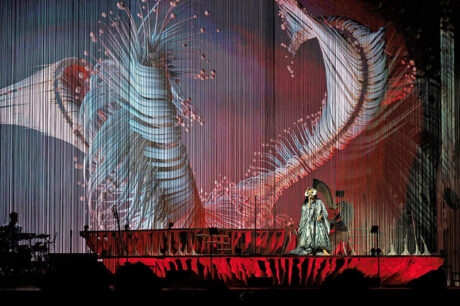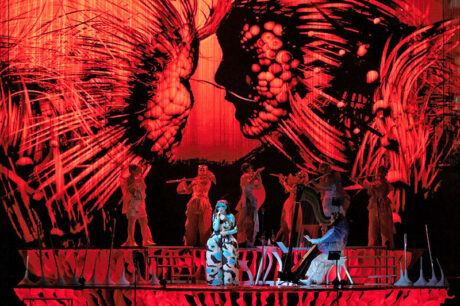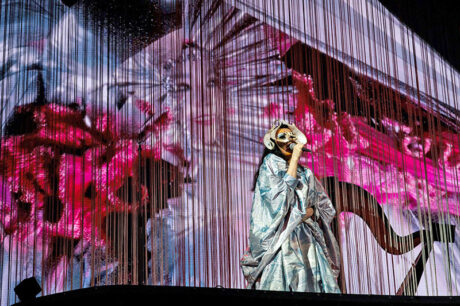
Icelandic singer / songwriter, and live performance trailblazer, Björk is touring her Cornucopia theatrical show globally through 2023. The focus of the show—initially produced as a series of one-off shows at the new arts venue, The Shed in New York, mid-2019—is nature and the environment, touching on some of its frontline issues. Cornucopia is a fantastic example of using lighting inventively to enhance a much larger mixed media ‘bigger picture’ that helps capture the many and varied expressions, emotions, moments, and messages of Björk’s work. The multi- year touring show’s concept was initiated by the artist herself and developed with creative collaborators James Merry and Argentinian film director Lucrecia Martel, whose influence brought an epic cinematic perspective and its own distinctive spirit and rhythm to the show. The eye-catching and cerebral video content was produced by Tobias Gremmler, which works beautifully with Chiara Stephenson’s striking and intricate scenic concepts. The elegant lighting design is co-designed by UK-based creatives Richard White and Bruno Poet.
Poet is well known as a theater and opera LD and for his creative lighting for bands like avant-rockers Sigur Ros, also from Iceland. White has worked for Björk as a programmer and lighting director on the road for the last six years. White explains how lighting was seminal to the quest to create a fully immersive audio, visual, and musical experience based on the utopian themes of the album. With a host of strong visual identities from the stage design, the theatrical performance of the musicians, and the incredible video content, he felt that the lighting “needed to complement, embellish and tie-in with all these elements and become the link between the physical and digital worlds,” in the process making performers appear in that same physical space in front of everyone’s eyes.

Utopian Lighting
Björk is heavily involved in all aspects of her live show productions, and she wanted all the show’s visual elements to look and feel organic and to have a fluid synergy. The stage floor was modeled on mushroom heads complete with their complex gill structures on the underside. Opening / closing string curtains stage left, right, and upstage center, together with a LED screen at the back, also added perspective and texturing. The utopian planet stage set’s spectacular main performance risers needed lighting in a very specific way to give the illusion of floating, and White and Poet immediately thought of Astera Titan Tubes. The riser undersides are constructed from a set of flocked/latex fungal gills, and the 24 Titan Tubes are positioned around the base of these gills. When operated in pixel mode, fluid waves of color bring the stage to a stunning three-dimensional life.
The stage/video design has three sets of automated tracked projection surfaces that interact with the risers to constantly shift and change the architecture of the space throughout the show. Often, performers are positioned in between layers of projection fabric, so White and Poet needed a small, punchy, and flexible lighting fixture that could be used at close quarters in places frequently inaccessible via a moving light overhead. Astera’s PixelBricks proved a great solution and were “perfect for this task,” notes White. They are neat-and-discreet in size, light in weight, and, like the Titan Tubes, can be operated wirelessly, which makes them easier to install and use while keeping the stage cleaner. Using the Astera products in this almost scenic context is popular right now, not just for live shows, but also for TV and broadcast scenarios.
During a UK / Europe leg, UK-based lighting rental specialist Liteup supplied lighting, video server, and control plus rigging equipment. At that time, Liteup provided 16 Martin MAC Viper Performance and 37 MAC Viper profiles for the main hard-edged moving lights, which were arranged on six overstage and two FOH trusses, joined by 29 GLP X4s as the primary wash lights. Thirty-two GLP X4 Bar 10s and 20 X4 Bar 20 LED battens were positioned on the overstage trusses in upstage and downstage rows. Poet and White wanted to be able to create multiple sunrise and sunsets for the utopian planet setting and with stage-wide shifts of color. Both GLP JDC1 and SGM Q2 strobes had been used throughout all the shows, offering a wealth of different effects from the same unit.
Also on the UK /Europe leg, White spec’d Q2s for the floor strobes and JDC1s for the overheads as they had swapped to a festival-style rolling stage with the floor units completely visible. Seeking a compact strobe that absolutely kicked, White dotted 20 Astera AX3 LightDrop battery powered LED pucks around the stage, providing a neat wireless up-lighting solution to highlight the mushroom gills and other set elements. “These were our footlights and sat on the stage set itself,” explained White. The goal was to achieve close angles and bring another dimension to the lighting but without cabling and fixing points. White had used them before and knew they’d be “perfect for this job.” They could be charged during the load-in and simply positioned and focused before doors each day.
A two base-station Robe RoboSpot system running with two BMFL WashBeams has been specified for Cornucopia right from the start, when this thought-provoking collage of image, lighting, sound, music, and movement was first staged at The Shed in New York in 2019. White describes the RoboSpots as “vital” for the show. All the tracking / following and sizing of the beams is undertaken by the RoboSpot operators, while he retains control all of the other parameters via the lighting console, a set up that allows for lightning quick reactions to the sudden changes in the stage space that come with the repeated curtain moves happening live throughout the performance. White also reveals that in terms of quality of light, he prefers the slightly softer feel of the BMFL WashBeam for this task. The two RoboSpots are positioned at FOH off to the sides to increase the subtlety of their impact on stage—the goal being that the artist should not even feel their presence. “We always try and spot Björk from a very side-on angle which isn’t always possible when touring multiple venues,” notes White. Using this system allowed him to keep control of all the color and intensity parameters from FOH, making the artist’s key light much more ‘live’ and controllable, particularly for this show with layered projection surfaces and automated drapes.
One of the biggest challenges for lighting was during the more video-driven songs, where people and set had to be lit in complementary and subtle ways, and serious detail went into finding angles “to create our effect but avoid any of the projection surfaces.” This was the primary reason they needed so many fixtures with framing shutters, and at one point, lights had to be rigged on the curtain trusses themselves in order to light performers while sandwiched between multiple curtains. The rigging detail comprised 136 motors from Liteup—a mix of quarter-ton, half-ton, 1-ton and 2-ton hoists—which were shared between lighting, audio, and video departments, together with 143 meters of Litec PR60 pre-rigged truss. Head rigger Steve Belfield worked alongside Toby Lee. Liteup’s project manager Dan Bunn worked closely with Belfield to work out multiple rigging solutions for a show that had to be millimeter accurate when it came to the positioning of all the elements each day. This included getting one of the truss structures re-engineered to achieve a result not possible with any off-the shelf-product.

Australian Festival Stop
The visually and sonically immersive Cornucopia recently stopped off to play a four-night residency at the 2023 Perth Festival in Western Australia. It was staged in a purpose-built 5,000 capacity pavilion in Langley Park, ensconced amid a ‘cybersonic Garden of Eden’ uniting nature and technology. For the Perth shows, equipment was supplied by local rental company Showscreens, including several Robe moving light fixtures from their extensive inventory. Gracing the rig were 18 Robe BMFL Blades, 20 BMFL Spots, 15 BMFL Wash Beams, 30 Spiiders, and 12 LEDWash 600s. White utilized the BMFL Blades for all the key lighting and sidelight. Their accurate framing shutter system is “essential” for this show, he notes, and that is due in a large part to the video projection’s multi-layered tracking curtain system. The BMFL Spots and WashBeams also made up the remainder of the flown and floor fixtures, and these were primarily used for effects and imaginative beam work. Working as an over-stage wash light, the Spiiders were highly efficient for covering all the necessary areas. Spiiders were also rigged on the audience trusses and augmented with the LEDWash 600s. They also supplied the two BMFL WashBeams on RoboSpot systems that are specified for the whole tour.
This content was edited together by Michael S. Eddy with information shared by Astera (www.astera-led.com), Robe lighting (www.robe.cz), and Liteup (www.liteup.co.uk).


